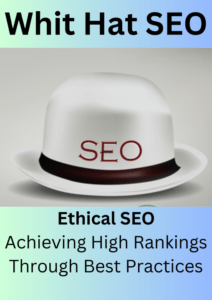Search Engine Optimization (SEO) plays a vital role in the success of websites and online businesses. It involves optimizing web pages to improve their visibility and ranking in search engine results pages (SERPs).
However, not all SEO techniques are created equal. Some follow ethical practices that adhere to search engine guidelines, while others resort to unethical tactics that can harm a website’s reputation.
In this blog, we will explore the principles of White Hat SEO, its benefits, and how you can implement these techniques to sustain your online success.
What is White Hat SEO?
White Hat SEO refers to a set of approved techniques and strategies that align with search engine guidelines and ethical standards. It focuses on optimizing websites for users rather than solely for search engines.
Professionals who practice White Hat SEO emphasize delivering high-quality content, improving user experience, and following the rules set by search engine algorithms.
Benefits of White Hat SEO
Implementing White Hat SEO techniques has several long-term benefits that can significantly impact the success of your online presence:
- Improved Website Visibility and Ranking: By following ethical practices, search engines recognize your website as trustworthy and relevant, resulting in higher rankings and better visibility in SERPs. Increased visibility leads to more organic traffic and potential conversions.
- Sustainable Website Traffic and Growth: White Hat SEO focuses on delivering valuable content and optimizing user experience, which keeps visitors returning to your website. This encourages sustained traffic growth and reduces reliance on paid advertising campaigns.
- Enhanced User Experience and Credibility: White Hat SEO techniques prioritize websites that offer a seamless and enjoyable user experience. By optimizing page load speeds, improving website navigation, and providing high-quality content, you establish credibility and trust with your audience.
- Risk Mitigation: White Hat SEO minimizes the risk of penalties and adverse impacts caused by algorithm updates. By adhering to search engine guidelines, you can maintain a consistent online presence without being penalized for unethical practices.
Check out this blog post to unlock the secrets of sustainable online success! #WhiteHatSEO “Success in the online world lies in the hands of those who embrace the ethical path. Discover the secrets of sustainable success with #WhiteHatSEO!”
Common White Hat SEO Techniques

On-page optimization involves optimizing the elements within your website to improve search engine rankings. Some key practices include:
- Keyword Placement: Conduct thorough keyword research and incorporate relevant keywords naturally into your content, headings, meta tags, and URLs.
- High-quality Content: Create informative and valuable content that meets the needs of your target audience. Use headings, bullet points, and subheadings to improve readability and organization.
- URL Optimization: Use clear and concise URLs that include relevant keywords and provide search engines with information about the page’s content.
Link Building
Link building is a critical aspect of White Hat SEO. Focus on acquiring high-quality backlinks from authoritative and reputable sources. Some effective strategies include:
- Content Promotion: Create engaging and shareable content that naturally attracts backlinks from other websites.
- Thought Leadership: Garner recognition as an industry expert through guest blogging, participating in interviews, and contributing to reputable publications.
- Internal Linking: Implement internal linking strategies to establish connections between related pages on your website.
User-friendly Website Design and Structure
A well-designed website with intuitive navigation enhances user experience and encourages visitors to explore more. It also signals to search engines that your site is user-friendly. Tips for creating a user-friendly website include:
- Mobile Optimization: Ensure your website is fully responsive and provides a seamless experience across all devices.
- Clear Site Structure: Organize your website into logical categories and subcategories, making it easier for visitors to find what they’re looking for.
- Intuitive Navigation: Implement clear and easy-to-use navigation menus and include a search bar to assist users in finding specific information.
Proper Use of Alt Tags and Image Optimization
Images play an important role in enhancing the visual appeal of a website, but they can also impact its performance if not optimized correctly. Some best practices for optimizing images include:
- Alt Text: Use descriptive alt tags for images to improve accessibility and assist search engines in understanding the context of the image.
- File Size Optimization: Compress images to reduce page load times without compromising quality.
- Image File Names: Give images descriptive names that include relevant keywords to help search engines understand their content.
Implementing White Hat SEO Techniques
To successfully implement White Hat SEO techniques, consider the following steps:
- Keyword Research: Identify relevant keywords that align with your business goals and incorporate them naturally into your content.
- Regular Content Updates and SEO Audits: Keep your website fresh and up to date by regularly publishing new content and periodically auditing your website for SEO improvements.
- Quality Backlink Building: Focus on building reputable and natural backlinks through content promotion and thought leadership efforts.
- Optimizing Website Loading Speed: Optimize your website’s performance by compressing images, minimizing scripts, and leveraging caching techniques.
- Leveraging Social Media: Utilize social media platforms to broaden your reach, engage with your audience, and drive traffic back to your website.
Contrasting White Hat SEO with Black Hat SEO
While White Hat SEO follows ethical guidelines, Black Hat SEO employs unethical practices that can lead to penalties and harm your website’s reputation in the long run. Common Black Hat SEO practices include:
- Keyword Stuffing: Overloading content with excessive and irrelevant keywords to try and manipulate search engine rankings.
- Cloaking: Showing different content to search engines and users in an attempt to deceive search engine algorithms.
- Link Buying: Purchasing backlinks from low-quality and irrelevant websites solely to boost search engine rankings.
By adhering to White Hat SEO principles, you can differentiate yourself from unethical practices and ensure the sustainability of your online presence.
Conclusion
White Hat SEO provides a sustainable approach to improving website visibility, ranking, and user experience. By focusing on quality content, ethical strategies, and following search engine guidelines, website owners can achieve long-term success.
Embrace White Hat SEO techniques, optimize your website, and watch your online presence grow organically while building trust, credibility, and sustainable online success.





